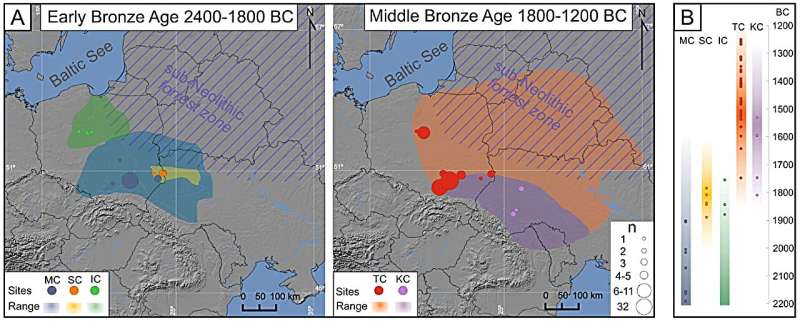August 2, 2023 report
This article has been reviewed according to Science X's editorial process and policies. Editors have highlighted the following attributes while ensuring the content's credibility:
fact-checked
peer-reviewed publication
trusted source
proofread
DNA study reveals shift in Bronze Age population in East-Central Europe

A team of researchers with a wide variety of backgrounds from institutions in Poland, Sweden, the U.K., Czech Republic and Ukraine has learned more about the demographic history of people living in East-Central Europe during the Bronze Age by studying the genes of people living during that time. For their paper published in the journal Nature Communications, the group conducted genetic analyses of temporal bones and/or tooth remains of 91 people.
As the research team notes, most demographic research focused on early Europe has been quite generalized, spanning from the postglacial spread of hunter-gatherers to the growth of migration by farmers. In this effort, they sought to better understand such demographic events in better detail. To that end, they obtained and studied teeth and bones from people who lived in different parts of East-Central Europe during the Bronze Age.
The work involved studying samples from 176 individuals, which they whittled down to 91. All the remaining samples were then sequenced, generating approximately 15,000 single-nucleotide polymorphisms, which allowed them to get a better perspective on the backgrounds of those individuals.
The researchers found that most of the early people living in the region at the time most resembled the Bell Beaker and Corded Ware cultures from the Neolithic. But they also found evidence of a shift during the Bronze Age as hunter-gatherers from other parts of Europe moved in, most particularly from the northeast. The research team notes more evidence of such a shift—a move to the use of large burial plots, for example, which were similar to those often seen during the Neolithic. They describe this shift as an admixture of hunter-gatherers. The researchers also found some ancestry from an unknown group, likely people that came from Neolithic farmers.
The team also found evidence suggesting that the admixture occurred further north, and those people or their offspring slowly moved south and east. They conclude that most of the people living in East-Central Europe during the Bronze Age were descendants of people from the Corded Ware culture, but also that some degree of comingling with steppe pastoralists had occurred.
More information: Maciej Chyleński et al, Patrilocality and hunter-gatherer-related ancestry of populations in East-Central Europe during the Middle Bronze Age, Nature Communications (2023). DOI: 10.1038/s41467-023-40072-9
Journal information: Nature Communications
© 2023 Science X Network



















